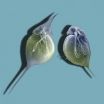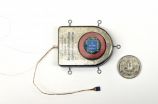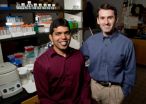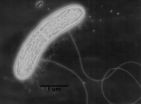(Press-News.org) Daphnia is a genus of small, planktonic crustaceans, commonly called 'water fleas' because of their jumpy swimming style and their size (between 0.2 and 5 mm). They live in various aquatic environments, ranging from acidic swamps to freshwater lakes, ponds, streams and rivers. Species of the genus Daphnia play a key role in freshwater food webs: they consume algae and are themselves an important food item for small fish.
Daphnia lumholtzi is a small subtropical and tropical representative, known as an invader in North America. It has never been found in Europe in the wild. Laboratory experiments were conducted by scientists from Ludwig-Maximilians-Universität München; University of Bayreuth; and Technische Universität, München, to assess the possibilities of a potential invasion in Europe. The study was published in the open access journal NeoBiota.
The experiments suggest that D. lumholtzi can invade European lakes and can cause substantial declines in the populations of native water flea species, e.g. Daphnia hyalina and D. cucullata. It was also shown that absence of predatory fish may ease establishment in European lakes. Surprisingly, the invasive plankter proved to be a strong competitor even at temperatures as low as 15°C, despite its tropical origin.
"We still do not know whether D. lumholtzi will invade European lakes, but our experiments did not identify any obstacles. In contrast to some studies suggesting that it might be filling an empty niche in North America, the results of our experiments indicate that it may suppress the population growth or even outcompete some native European Daphnia" says the lead author Meike J. Wittmann.
INFORMATION:
Original Source:
Meike J. Wittmann, Wilfried Gabriel, Eva-Maria Harz, Christian Laforsch, Jonathan M. Jeschke, Can Daphnia lumholtzi invade European lakes? NeoBiota: 16: 39, doi: 10.3897/neobiota.16.3615
Licensing:
This press release is available under the Creative Commons Attribution 3.0 License. It is expected to link back to the original article.
Pensoft Publishers
Can a tropical water flea invade European lakes?
Experiments predict that populations of native European species may be substantially suppressed by the invader
2013-03-19
ELSE PRESS RELEASES FROM THIS DATE:
Caterpillar-walk exhumation, the downfall of the Moche, and trilobites in camouflage
2013-03-19
Boulder, Colo., USA – New Geology articles posted online ahead of print cover everything from cratering on Mars to leopard-like camouflage in trilobites. Locations studied include the Ries Impact Crater; Hydrate Ridge, Oregon; Stromboli volcano; northern Peru; the Bushveld Complex, South Africa; western and central New York state; the Sahara Desert; and the French Alps. Brief highlights follow:
1. Analogous cratering at the Ries Impact Crater, Germany, and on Mars;
2. A presentation of the first secure, high-resolution land-sea PSV-based sediment-core synchronization;
3. ...
Wireless, implanted sensor broadens range of brain research
2013-03-19
A compact, self-contained sensor recorded and transmitted brain activity data wirelessly for more than a year in early stage animal tests, according to a study funded by the National Institutes of Health. In addition to allowing for more natural studies of brain activity in moving subjects, this implantable device represents a potential major step toward cord-free control of advanced prosthetics that move with the power of thought. The report is in the April 2013 issue of the Journal of Neural Engineering.
"For people who have sustained paralysis or limb amputation, rehabilitation ...
DNA catalysts do the work of protein enzymes
2013-03-19
CHAMPAIGN, Ill. — Illinois chemists have used DNA to do a protein's job, creating opportunities for DNA to find work in more areas of biology, chemistry and medicine than ever before.
Led by Scott Silverman, a professor of chemistry at the University of Illinois at Urbana-Champaign, the researchers published their findings in the journal Proceedings of the National Academy of Sciences.
Ideally, researchers would like to be able to design and build new catalysts from scratch that can do exactly what they want. Many enzymes make small modifications to the building blocks ...
UMass Amherst researchers reveal mechanism of novel biological electron transfer
2013-03-19
AMHERST, Mass. – When researchers at the University of Massachusetts Amherst led by microbiologist Derek Lovley discovered that the bacterium Geobacter sulfurreducens conducts electricity very effectively along metallic-like "microbial nanowires," they found physicists quite comfortable with the idea of such a novel biological electron transfer mechanism, but not biologists.
"For biologists, Geobacter's behavior represents a paradigm shift. It goes against all that we are taught about biological electron transfer, which usually involves electrons hopping from one molecule ...
Sex between monogamous heterosexuals rarely source of hepatitis C infection
2013-03-19
Individuals infected by the hepatitis C virus (HCV) have nothing to fear from sex in a monogamous, heterosexual relationship. Transmission of HCV from an infected partner during sex is rare according to new research published in the March issue of Hepatology, a journal published by Wiley on behalf of the American Association for the Study of Liver Diseases (AASLD).
Experts estimate that HCV affects up to 4 million Americans, most of whom are sexually active. Medical evidence shows HCV is primarily transmitted by exposure to infectious blood, typically through intravenous ...
Greenhouse gas policies ignoring gap in household incomes: University of Alberta study
2013-03-19
Government policies aimed at reducing greenhouse gas emissions from consumers need to be fairer for household income levels, says a University of Alberta researcher.
A U of A study published recently online in the journal Environment and Behaviour looks at the different sources of greenhouse gas emissions from consumers, based on their income levels. The wealthiest households in Alberta emit the most greenhouse gases, but too often, income disparity hasn't been factored in to current polices—such as the carbon flat tax that is levied to British Columbia residents.
Such ...
Kill Bill character inspires the name of a new parasitoid wasp species
2013-03-19
Parasitoid wasps of the family Braconidae are known for their deadly reproductive habits. Most of the representatives of this group have their eggs developing in other insects and their larvae, eventually killing the respective host, or in some cases immobilizing it or causing its sterility. Three new species of the parasitoid wasp genus Cystomastacoides, recently described in the Journal of Hymenoptera Research, reflect this fatal behavior.
Two of the new species were discovered in Papua New Guinea, while the third one comes from Thailand. The Thai species, Cystomastacoides ...
Newly incarcerated have 1 percent acute hepatitis C prevalence
2013-03-19
A study published in the March issue of Hepatology, a journal of the American Association for the Study of Liver Diseases, estimates that the prevalence of acute hepatitis C virus (HCV) infection is nearly one percent among newly incarcerated inmates with a history of recent drug use. Findings suggest that systematic screening of intravenous (IV) drug users who are new to the prison system could identify more than 7,000 cases of HCV across the U.S. annually—even among asymptomatic inmates.
According to the National Institute of Allergy and Infectious Diseases Health—the ...
Pre-college talk between parents and teens likely to lessen college drinking
2013-03-19
Teen-age college students are significantly more likely to abstain from drinking or to drink only minimally when their parents talk to them before they start college, using suggestions in a parent handbook developed by Robert Turrisi, professor of biobehavioral health, Penn State.
"Over 90 percent of teens try alcohol outside the home before they graduate from high school," said Turrisi. "It is well known that fewer problems develop for every year that heavy drinking is delayed. Our research over the past decade shows that parents can play a powerful role in minimizing ...
Brain-mapping increases understanding of alcohol's effects on first-year college students
2013-03-19
A research team that includes several Penn State scientists has completed a first-of-its-kind longitudinal pilot study aimed at better understanding how the neural processes that underlie responses to alcohol-related cues change during students' first year of college.
Anecdotal evidence abounds attesting to the many negative social and physical effects of the dramatic increase in alcohol use that often comes with many students' first year of college. The behavioral changes that accompany those effects indicate underlying changes in the brain. Yet in contrast to alcohol's ...
LAST 30 PRESS RELEASES:
Ticking time bomb: Some farmers report as many as 70 tick encounters over a 6-month period
Turning garden and crop waste into plastics
Scientists discover ‘platypus galaxies’ in the early universe
Seeing thyroid cancer in a new light: when AI meets label-free imaging in the operating room
Neutrophil-to-lymphocyte ratio may aid risk stratification in depressive disorder
2026 Seismological Society of America Annual Meeting
AI-powered ECG analysis offers promising path for early detection of chronic obstructive pulmonary disease, says Mount Sinai researchers
GIMM uncovers flaws in lab-grown heart cells and paves the way for improved treatments
Cracking the evolutionary code of sleep
Medications could help the aging brain cope with surgery, memory impairment
Back pain linked to worse sleep years later in men over 65, according to study
CDC urges ‘shared decision-making’ on some childhood vaccines; many unclear about what that means
New research finds that an ‘equal treatment’ approach to economic opportunity advertising can backfire
Researchers create shape-shifting, self-navigating microparticles
Science army mobilizes to map US soil microbiome
Researchers develop new tools to turn grain crops into biosensors
Do supervised consumption sites bring increased crime? Study suggests that’s a myth
New mass spec innovation could transform research
Maternal nativity, race, and ethnicity and infant mortality in the US
Migration-related trauma among asylum seekers exposed to the migrant protection protocols
Jupiter’s moon Europa has a seafloor that may be quiet and lifeless
SwRI upgrades nuclear magnetic resonance laboratory for pharmaceutical R&D
House sparrows in northern Norway can help us save other endangered animals
Crohn's & Colitis Foundation survey reveals more than 1/3 of young adults with IBD face step therapy insurance barriers
Tethered UAV autonomous knotting on environmental structures for transport
Decentralized social media platforms unlock authentic consumer feedback
American Pediatric Society announces Vanderbilt University School of Medicine as host institution for APS Howland Visiting Professor Program
Scientists discover first method to safely back up quantum information
A role for orange pigments in birds and human redheads
Pathways to net-zero greenhouse gas emissions for Southeast Asia
[Press-News.org] Can a tropical water flea invade European lakes?Experiments predict that populations of native European species may be substantially suppressed by the invader




